HISTORY OF UNIMOG AND MUSEUM OF GAGGENAU
Originally from the Daimler-Benz AG factories in the immediate post-war period, Albert Friedrich began in 1945 the development of a compact and universal agricultural vehicle which he already had in mind during the war.
Very different from conventional agricultural tractors, this one had to be universal : integral 4x4 transmission with differential locks, four equal wheels, 25 hp, which must act as a tractor with front, back and side tool holders, standardized thereafter, load space and front, rear and center power take-offs. It had to be able to move at a speed of 50 km /h, relatively high, to transport on its board various products, which already made it a small truck. It will therefore be equipped with helical springs long travel suspension and portal axels ensuring a good ground clearance. Metal casing enclosing the transmission shafts were integral with the axles and articulated by ball joints at the output of the power take-off. The vehicle was modest but really stood out from the traditional agricultural tractors of the time and bought transport solutions with very good off-road capabilities, its strong point. It will later be used more as a forestry tractor than as a farm tractor, when true agricultural tractors will be improved with driving front axles.
Erhard & Söhne, a manufacturer of gold and silver products in Schwäbisch-Gmünd, has been involved in the development and production of the first U1 prototype, which began with Heinrich Rossler, also of Daimler-Benz AG, as production manager in January 1946. The U1 proto had an M 135 petrol engine, a four-speed ZF gearbox. Engineers like Karl Rank, Hans Zabel were then hired. The first prototype rolled on October 9, 1946.
The three following prototypes with petrol engines were also built in Schwäbisch Gmünd in 1946-1947. In 1946 Hans Zabel named UNIMOG : ‘Universal-Motor-Gerät’, universal motorized vehicle. After a few tests and a public presentation in the spring of 1947, a new OM 636 diesel engine developed by Daimler-Benz's Julius Witzky marine engine designer was suitable for the vehicle and the last two U5 and U6 prototypes with this diesel engine and a specially designed 6-speed gearbox, were gradually built in the Boehringer Brothers machine-tools factory in Göppingen. In 1948, Unimog was presented to the public at the Frankfurt Agricultural Fair, which registered 150 orders. The production started in August 1948 in Göppingen and 600 vehicles ‘70200’ were built in two years. Not only the farmers but also foresters, municipalities and administrations, contractors, firemen, armies were interested.
Daimler-Benz including interest of this vehicle took over the entire project, including the newly created patents, designers and distribution department and moved manufacturing to Gaggenau in the former Mercedes truck factory. Consequently, the large investments needed to increase production were possible.
The small vehicle with its typical silhouette, its plunging hood, high on legs, big wheels and very off-road, began to spread in Germany and later in many countries.
In 1972, a new truly agricultural tractor, the MB-Trac, combined Unimog technology (equal wheels 4x4) with a tractor silhouette : the long, tapered engine hood precedes a square driver's cab that rises in height and, unlike traditional tractors, was installed between the axles and completely closed. The MB-Trac was the car among the tractors.
On the basis of the original MB-Trac 65 and MB-Trac 70 (later 700), a wide range of tractors extended to the very powerful MB-Trac 1800 in a few years. However, this model did not meet the expected success and Daimler-Benz later added MB-Trac to the farm machinery business of Deutz. The reduction of the number of farms and a somewhat higher price compared to the competitors will overcome this concept. The MB-Trac production stopped in 1991.
To return to Unimog, after many years, the manufacture was transferred from Gaggeneau to Wörth am Rhein in 2002, about forty kilometers North of Gaggeneau.
Nowadays (December 2016), only the light series 405 : U 216, U 218, U 318, U423, U427, U 430, U 247, U 530 and the heavy series 437,4 : U 4023, U 5023 are manufactured. The new diesel engines meet Euro VI standards. Apart from agriculture where they are relatively few, Unimog are used in forestry, armies, rescue organizations, maintenance of roads, expeditions, fighting forest fires, work in the energy sector. It is always said that the Unimog move forward where its competitors abandon.
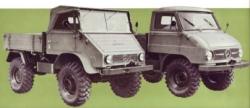
Unimog 411 U25, U30, U35, U34, U36, built at 40,000 copies from 1956 to 1974. It comes from the basic series 401/402 with a power of 25 hp, then 30, 32, 34 and 36 hp. Above: Unimog 411.119U30, 34PS, 1966 and the 411.20 Westfalia Type B enclosed cabin built from August 1956 to October 1961 to 5,000 units. |
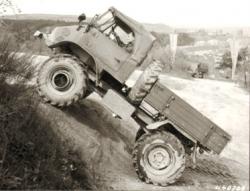 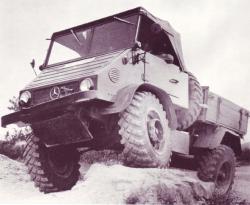 |
|
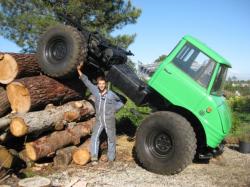
Unimog 416. http://www.unimog-mania.com/t1245p50-mon-416-trial-boulo-en-cours-de-fabrication
|
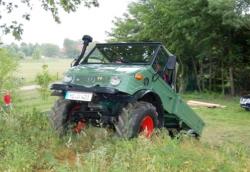
The series 421 U 40, U 45, U 52, U 55, U 60, U 600 (1965-1989 to 19000 units) range from 40 to 60 hp, based on the series 411. Above, Unimog 421.140. |
|
Unimog 421 124 U52 with open cab 1969 |
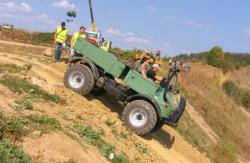 |
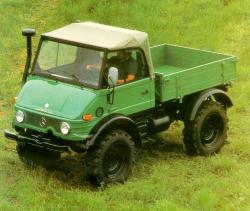 |
|
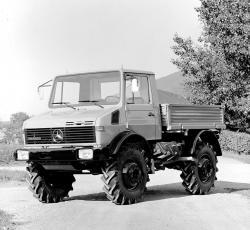
Series 425 U 1300 and U 1500 (1975-1988 to 3.135 copies) is a complementary heavy series for demanding work. The 425 series starts with 120 hp (soon after, 125 hp on the U 125), a wheelbase of 2,810 mm and a P.T.A.C. of 9 t. It is characterized by a new cabin of square shape which opens on a large front part painted in black and accompanied by a dipping hood. The basic features of the exterior design of the cab remain basically the same until today, more than a quarter of a century later. In October 1974, the series U 411, 34 hp is no longer built after 39.000 copies produced. http: //soulsteer.blogspot.fr/2016/01/rare-black-white-pictures-of-4wd-truck.htmlUnimog 6x6 was based on the U 1200 of the 424 series, short wheelbase. It was built by Sulzer Company. The cab was modified because of the third axle. Used in a strawberry plantation in Tirol, Austria, the third axle reduced strawberry ground pressure, so impact on plants was not important. http://www.unimog-mania.com/t18-au-boulot-les-unimog, http://www.benzworld.org/forums/unimog/1547046-monster-fire-mog-2.html#post4376584 |
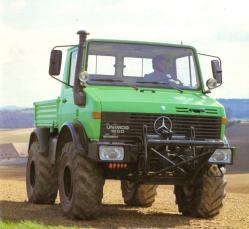
Séries 424 (1976-89 to 11,233 units), is a light series of the series 425 with 6 models : U 1000, U 1200, U 1250, U 1250 L, U 1550, U 1550 L.Series U 435, based on the U 425 series, U 1300 L, U 1300 L/37, U 1500 L/37, U 1700, U 1750 L / 38, U 1750, U 1750 L, U 1750 L / 38, 8 models built from 1975 to 1993 to 30.726 copies including the U 1300 L, delivered in large numbers to the German Army, firemen and civilians.The production of the series 435, 1975-1993 to 30.726 units, U 1700, U 1700 L, U 1300 L, for the army is the successor to the Mercedes-Benz Unimog S and is characterized by a long wheelbase of 3,250, 3,700 or even 3,850 mm. The 424 series, U 1000, 1976-1989, positioned in a lower category.
|
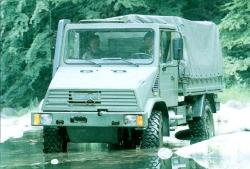
Series 408/U 90 and 418 U 140, 416 U 110 from 1992 to 2001). Fully redesigned larger cab, simple controls and user-friendly working environment, tire pressure control, anti-lock braking system, the U 90 is increasingly appreciated by municipal services. |
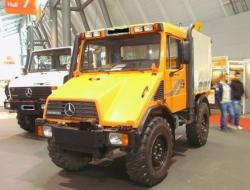
Series 408 U 90 turbo at Retro Classics, Stuttgart 2014.Unimog U 90 http://www.benzworld.org/forums/unimog/1474044-u90-u140-series-4.html |
Mercedes series 408 U 90 (and 418 U 140) Funmog, 1994. Recreational vehicle with chrome, leather, air-conditioned, hands free phone, improved sound. It was elected 'Offroader of 1994 year'. |
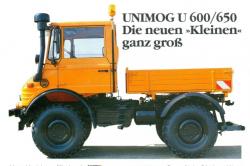 |
On left : Unimog U 407 U 600, U 650, U 650 L, to 789 copies, 52 and 60 hp / U 417 to 2275 copies, 7 models U 800, U 900, U 1100, U 1150, U 1150 L, U 1150 L / 34 (1988-1993), 75 and 110 hp. It have a round shape that has become classic. The Unimog with a rounded cabin belong to the light range, while the new series with an angular cabin are classified in the middle range or the heavy range, according to their P.T.A.C. Some engines overlap, the Unimog nomenclature is not easy to understand.
|
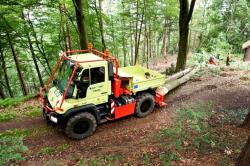
|
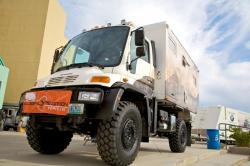
Global Expedition Vehicles Freightliner Unimog U 500 at the Overland Expo in 2009 |
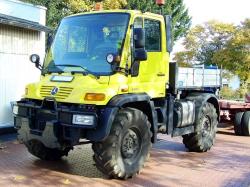 |
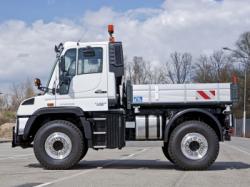
Second generation series 405 U 218, U 423 above, U 430, U 300, 2013 to present. |
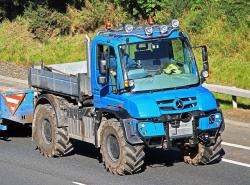 |
UNIMOG series 405, U 216, 156 hp to U 530, 299 hp (on left), 13 models. Off-road but differential locks on demand. 90 km/h. Light and heavy actual Unimog (December 2016), are here :http://www.mercedes-benz.co.uk/content/unitedkingdom/mpc/mpc_unitedkingdom_website/en/home_mpc/Unimog/home/unimog_overview/applications.html, https://www.flickr.com/photos/mikealaska/21733533768/in/photostream/ |
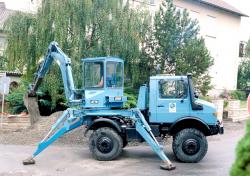 |
Unimog series 427 U 1200 (on left), U 1600, U 1650, 1980-2000. |
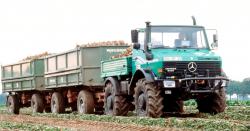
Unimog series 437 U 2100/U 2150/U 2450, 1980-2000, U 4000, U 5000, 2000-2013. On left is a U 2100. https://en.wheelsage.org/mercedes-benz/unimog/23438/pictures/316923/ |
|
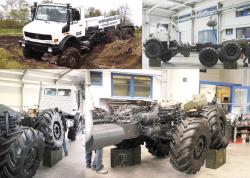 |
Unimog series 437 U 2450 L 6X6. http://www.unimog-mania.com/t1527-unimog-6x6-de-francis-le-scoop |
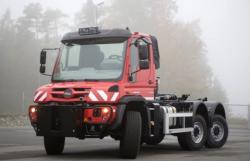
U 530 6x6 (2016) |
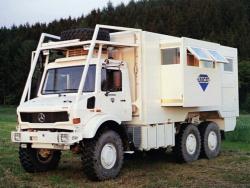
Unicat Mercedes-Benz Unimog U 2450 L 6x6 launched 1993. https://www.youtube.com/watch?v=K9Yy_yIbC9U |
|
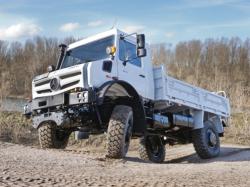
Series 437.4, U 4023 (2015 to present) are camping cars issued from U 435, U 5023, (above), 2013 to present.Mercedes-Benz Concept, the U5000-based design, 2011. The concept that celebrates these 60 years resumes the principle of the original model, a discoverable all-terrain truck. Created in cooperation between the MBS teams and the Sindelfingen style studio, this concept particularly emphasizes the capabilities of the machine with its structure and its apparent suspensions. http://www.autobild.de/bilder/bilder-mercedes-unimog-designstudie-1796499.html#bild1 |
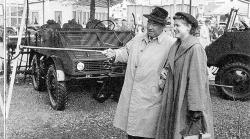
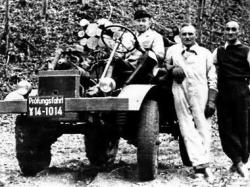
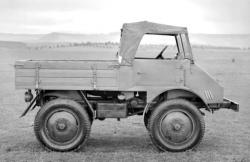
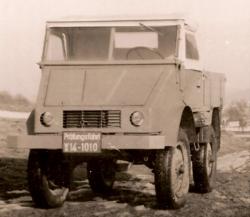
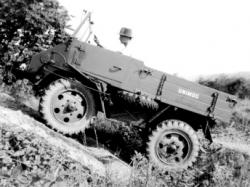
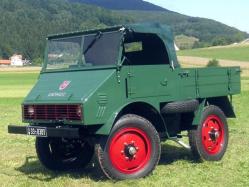
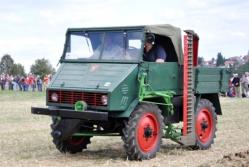
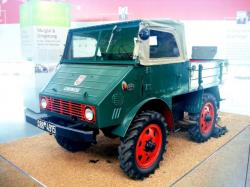
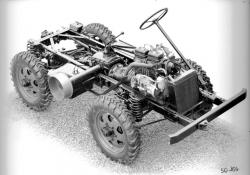
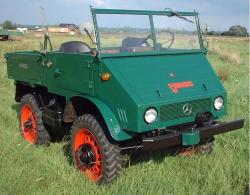
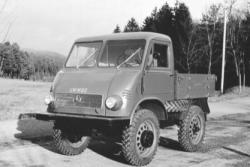
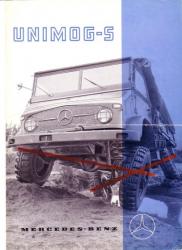
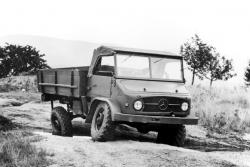
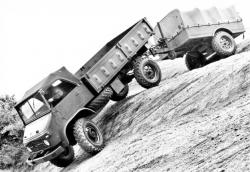
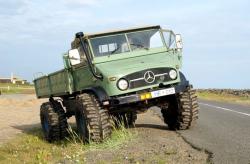
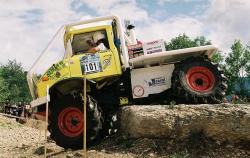
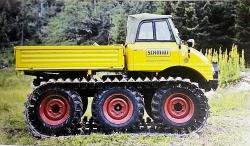
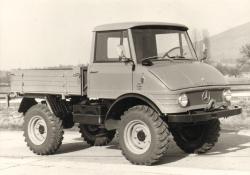
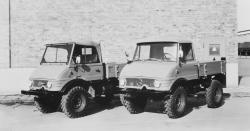
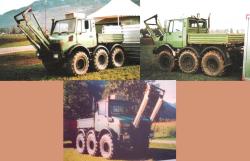
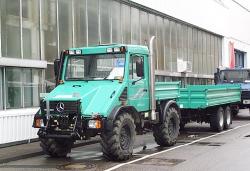

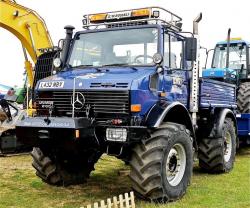
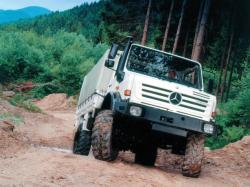
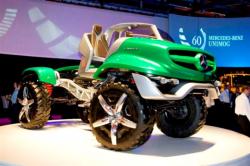
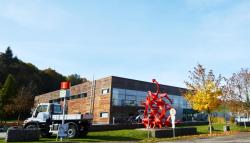
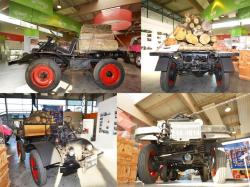
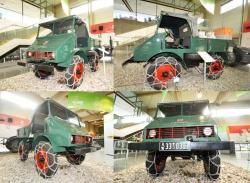
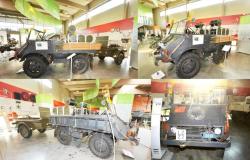
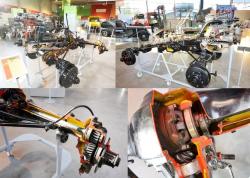


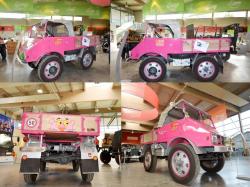

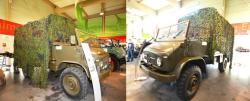
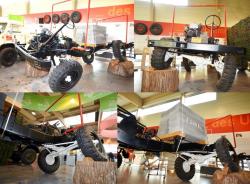



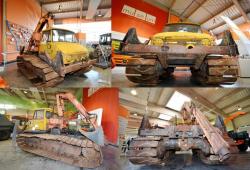

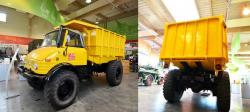
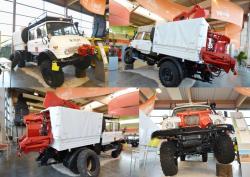
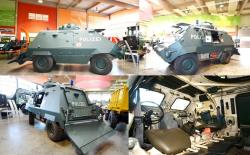
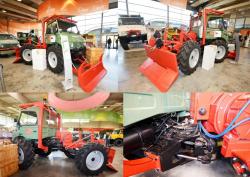
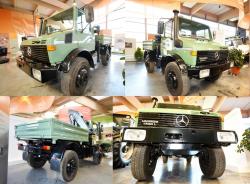
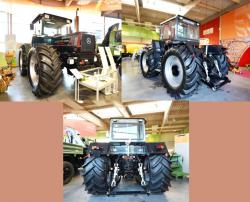
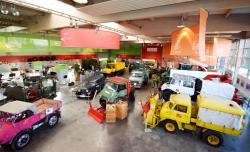
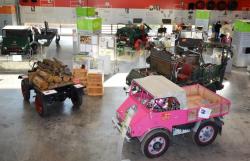
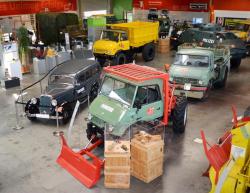

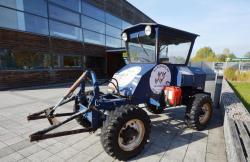
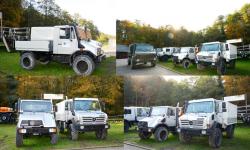

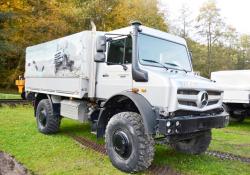

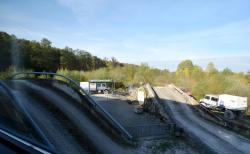
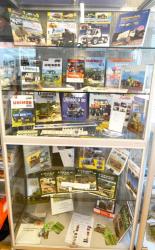
 Français
Français
 English
English
 Español
Español
 Italiano
Italiano
 Deutsch
Deutsch
 Nederlands
Nederlands
 Portuguesa
Portuguesa